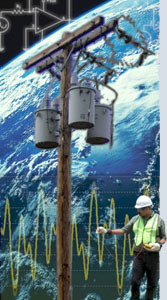Standards and Regulations
To date, just a few states and provinces have addressed levels of human and animal sensitivity to perceptible contact voltages. Most notable are the limits imposed on dairy farms in Wisconsin, where voltage levels may not exceed 0.5 volts in terms of utility contribution and 0.5 volts in terms of customer contribution. The net value, 1 volt, has some solid rationale behind it. For example, comprehensive animal testing has shown that Approximately one percent of dairy cows react to as little as 2 volts RMS. Therefore, a value of one half of that level (1 V RMS) was chosen as the "level of concern" or level that requires remedial action. Other Midwestern states have adopted the Wisconsin recommendations, and the most recent action on this has been adoption by the Canadian province of Ontario.
In terms of human perception of voltage, testing has shown that a small percentage of humans can sense voltages as low as one or two volts under wet conditions (such as in a swimming pool). However, no states have issued regulations regarding any type of levels of concern. One reason for this is that in the majority of cases, these perception issues at swimming pools and spas tend to be most prevalent when the decking does not have rebar and/or metal parts around the water have not been properly bonded.
The State of New York presently has a rule that requires annual scanning or measurements of power system equipment and structures (manholes, services boxes, street and traffic lights, etc.) to locate and then mitigate contact voltage conditions if the measured voltage is above 4.5 Vac (or 1 Vac in NYC) and the contact condition has been determined to be attributable to a repairable condition.
The IEEE Power Engineering Society convened the IEEE 1695 Working Group to develop a guide for measurement and diagnostic issues surrounding the topic of "Voltages at Privately and Publicly Accessible Locations." After ten years of work and research, this working group published IEEE 1695-2016, "IEEE Guide to Understanding, Diagnosing, and Mitigating Stray and Contact Voltage."
The IEC Technical Committee 64 has sponsored creation of a document series titled IEC 60479 - Effects of Current on Human Beings and Livestock. This document has three separate volumes:
- Part 1 1994 General Aspects – Humans (60479-1). Addresses effects of currents up to 100 Hz on humans.
- Part 2 1987 Special Aspects – Humans (60479-2). Addresses effects of currents greater than 100 Hz, as well as special waveforms of current and single-shot unidirectional impulses.
- Part 3 1998 Effect of Currents Passing Through the Bodies of Livestock (60479-3). Addresses the various categories of livestock, primarily cows, and some graphical information on pigs, sheep, calves, and ponies.
The document series is available from various on-line standards document services. Present and previous work done to develop the series included literature searches, questionnaires, and publication analysis (performed by the Technical Committee 64). The report series attempts to correlate duration of current flow to ventricular fibrillation and cardiac physiology. Additional information on human and animal body resistances and effects of differing voltage waveforms and frequencies are also detailed.
Along with the previously discussed documents and rules, there are approximately fifteen other standards that have a published limit or level of concern. The documents and their relevance to the subject matter can be found in the following reference publication:

